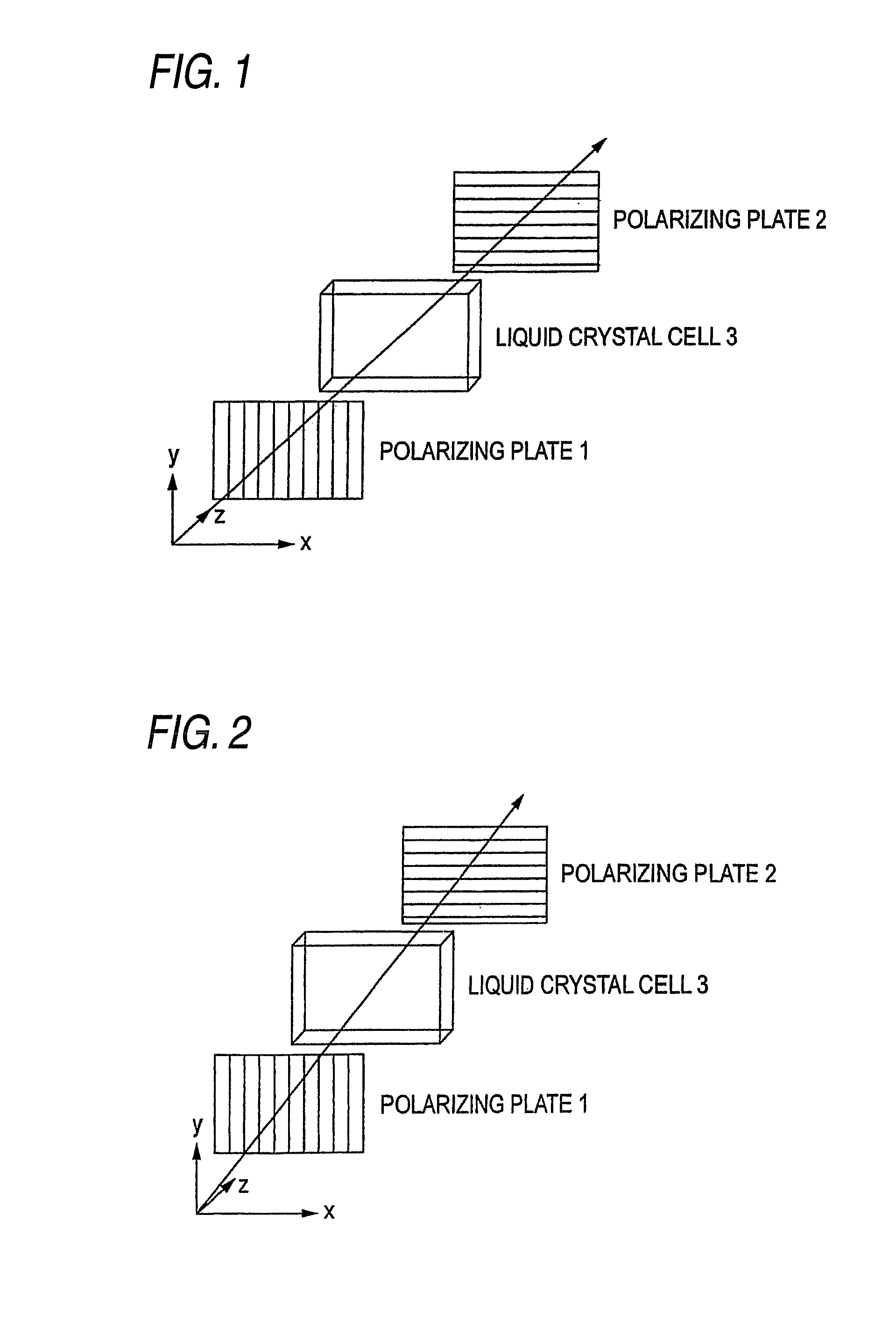Liquid Crystal Display Device
a liquid crystal display and display device technology, applied in non-linear optics, instruments, optics, etc., can solve the problems of narrow viewing angle, light leakage, and above cannot meet these requirements, and achieve the effect of high viewing angle and small color shi
- Summary
- Abstract
- Description
- Claims
- Application Information
AI Technical Summary
Benefits of technology
Problems solved by technology
Method used
Image
Examples
example 1
[Production of Viewing-Side Polarizing Plate Protective Films (F-1 to F-8)]
(1) Production of F-1
[0238]Respective components shown in Table 1 below were mixed to prepare a cellulose acylate solution. This cellulose acylate solution was cast on a metal support, and the obtained web was separated from the band support to produce Transparent Film F-1. The film thickness was 70 μm.
TABLE 1ComponentCellulose acylate with an acetyl100parts by weightsubstitution degree of 2.87Triphenyl phosphate5parts by weightBiphenyl phosphate3parts by weightRetardation Controlling Agent A6parts by weightRetardation Controlling Agent B5parts by weightMethylene chloride544parts by weightMethanol81parts by weightMatting agent (AEROSIL R972,0.05parts by weightproduced by Nippon Aerosil Co.,Ltd.)(Retardation Controlling Agent A)(Retardation Controlling Agent B)
(Evaluation of Optical Performance)
[0239]The Re retardation value and Rth retardation value at wavelengths of 450 nm, 550 nm and 630 nm were measured a...
example 2
[Production of Backlight-Side Polarizing Plate Protective Films (R-1 and R-2)]
(1) Production of R-1
[0248]Respective components shown in Table 6 below were mixed to prepare a cellulose acylate solution. This cellulose acylate solution was cast on a metal support. The film stripped off from the metal support in a state of the residual solvent amount being from 25 to 35 mass % was 3% stretched in the longitudinally direction within the section from stripping to a tenter under the conditions of a stretching temperature of about Tg−5° C. to Tg+5° C. and then stretched in the width direction at a stretch ratio of 32% by using a tenter and immediately after the transverse stretching, the film was shrunk in the width direction at a ratio of 7% and then removed from the tenter to prepare a cellulose acylate film. The film thickness was 80 μm.
TABLE 6ComponentCellulose acylate with an acetyl100parts by weightsubstitution degree of 2.81Triphenyl phosphate7.8parts by weightBiphenyl phosphate3.9...
example 3
[0255]A 80 μm-thick polyvinyl alcohol (PVA) film was dyed by dipping it in an aqueous potassium iodide solution having a potassium iodide concentration of 2 mass % at 30° C. for 60 seconds, then longitudinally stretched to 5 times the original length while dipping the film in an aqueous boric acid solution having a boric acid concentration of 4 mass % for 60 seconds, and dried at 50° C. for 4 minutes to obtain Polarizer A of 20 μm in thickness.
[0256]Also, a 80 μm-thick polyvinyl alcohol (PVA) film was dyed by dipping it in an aqueous potassium iodide solution having a potassium iodide concentration of 12 mass % at 30° C. for 60 seconds, then longitudinally stretched to 5 times the original length while dipping the film in an aqueous boric acid solution having a boric acid concentration of 4 mass % for 60 seconds, and dried at 50° C. for 4 minutes to obtain Polarizer B of 20 μm in thickness.
[0257]The protective films produced in Examples 1 and 2 shown in Tables 5 and 8 and a commerci...
PUM
| Property | Measurement | Unit |
|---|---|---|
| wavelength | aaaaa | aaaaa |
| temperature | aaaaa | aaaaa |
| thickness | aaaaa | aaaaa |
Abstract
Description
Claims
Application Information
 Login to View More
Login to View More - R&D
- Intellectual Property
- Life Sciences
- Materials
- Tech Scout
- Unparalleled Data Quality
- Higher Quality Content
- 60% Fewer Hallucinations
Browse by: Latest US Patents, China's latest patents, Technical Efficacy Thesaurus, Application Domain, Technology Topic, Popular Technical Reports.
© 2025 PatSnap. All rights reserved.Legal|Privacy policy|Modern Slavery Act Transparency Statement|Sitemap|About US| Contact US: help@patsnap.com



